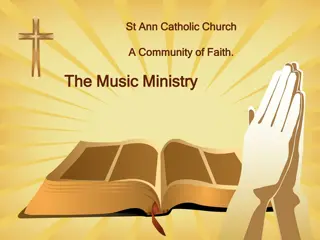All About Mardi Gras: History, Traditions, and Celebrations
Mardi Gras is a festive celebration observed before Lent, featuring rich foods, parades, and colorful traditions like wearing masks and tossing beads. Originating centuries ago, Mardi Gras has become a global phenomenon, with New Orleans hosting the largest festivities. Learn about the history, significance, and various customs associated with this vibrant annual celebration.
Download Presentation

Please find below an Image/Link to download the presentation.
The content on the website is provided AS IS for your information and personal use only. It may not be sold, licensed, or shared on other websites without obtaining consent from the author.If you encounter any issues during the download, it is possible that the publisher has removed the file from their server.
You are allowed to download the files provided on this website for personal or commercial use, subject to the condition that they are used lawfully. All files are the property of their respective owners.
The content on the website is provided AS IS for your information and personal use only. It may not be sold, licensed, or shared on other websites without obtaining consent from the author.
E N D
Presentation Transcript
What Is Mardi Gras? Mardi Gras is traditionally a day people indulge in rich food and celebration before Lent. Lent is a 40-day time period in which Christians fast and praise in preparation for Easter.
When Is Mardi Gras? The Mardi Gras celebration is the last day of the Carnival season and the day before Ash Wednesday. The Carnival season begins on January 6th. During this time, there are parades and balls.
What Is Carnival? Carnival is a season of celebration before the religious event of Lent. During this time, there are parades and balls. People spend time indulging in good food and drinks. Mardi Gras is the last day of Carnival.
When Was the First American Mardi Gras? There is a debate about when the first American Mardi Gras celebration occurred. Many historians believe it occurred on March 3, 1699. Others believe it occurred in 1703.
The Many Name of Mardi Gras Mardi Gras is also referred to as Fat Tuesday Shrove Tuesday Pancake Day
New Orleans, LA Mardi Gras is celebrated all over the world, but the largest celebration is in New Orleans, Louisiana. New Orleans The first Mardi Gras parade was on February 24, 1857 in New Orleans.
Traditional Colors The traditional symbolic colors of Mardi Gras are purple, green, and gold. Purple = Justice Green = Faith Gold = Power
Krewes Krewes are an important part of Mardi Gras. Krewes are groups or organizations who come together to host a Mardi Gras ball, ride on a parade float, and participate in social events throughout the year.
Masks Masks and costumes are a large part of the Mardi Gras tradition. It is illegal to ride a Mardi Gras float without a mask!
Beads Beads are a popular Mardi Gras tradition. The original idea was to pass beads out during the parade to people who exhibited the traits of the three Mardi Gras colors: justice, faith, power.
Zulu Coconuts Zulu coconuts are another popular Mardi Gras tradition. The coconuts were originally left in their natural state but are now decorated and covered in glitter.
King Cakes King Cakes are Mardi Gras s most popular food. They began as a simple ring of dough. The most popular King Cake now is a braided Danish pastry iced with purple, green, and gold icing.























